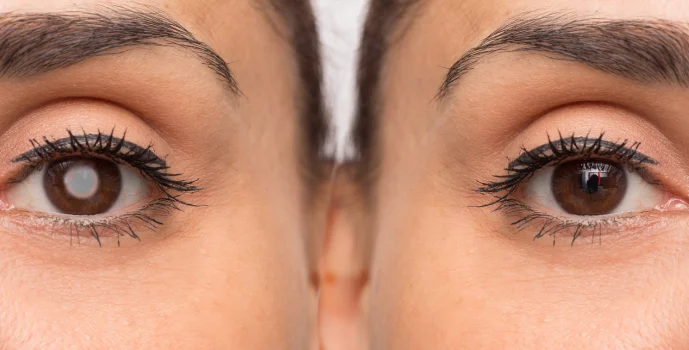
Refractive Lens Exchange (RLE): A Clearer Vision Beyond Glasses
At Pro Sight Eye Hospital, we believe in offering more than just treatment — we believe in giving you confidence, clarity, and freedom from visual limitations. Among our advanced vision correction options — including LASIK and cataract surgery — one of the most effective long-term solutions is Refractive Lens Exchange (RLE).
It’s a safe and predictable way to achieve lasting visual clarity, especially for people who may not be ideal candidates for corneal laser procedures.
What Is RLE?
Refractive Lens Exchange (RLE), also known as clear lens extraction, is a surgical procedure in which your eye’s natural (clear) lens is replaced with an artificial intraocular lens (IOL).
Unlike cataract surgery — which treats a cloudy lens — RLE is performed electively to improve vision and reduce dependence on glasses or contact lenses.
While LASIK reshapes the cornea to correct refractive errors, RLE works differently — it replaces the lens inside your eye. This makes it a better option for people with high prescriptions or early age-related vision changes.
Because RLE uses techniques similar to cataract surgery, it’s a time-tested and reliable procedure with predictable results.
Why Consider RLE?
RLE is not just an alternative to laser-based correction — it’s often the preferred choice for people who:
- Have high refractive error (extreme near- or farsightedness) that lies outside the safe range for corneal laser surgeries.
- Struggle with presbyopia — age-related near-vision problems that usually start after 40.
- Have thin corneas or dry eyes, which make corneal laser procedures less suitable.
- Want to avoid future cataract surgery, since the natural lens is already replaced.
In short, RLE offers a “lens-based” correction for vision problems that laser procedures may not be able to address effectively.
How the Procedure Works
Here’s what typically happens during Refractive Lens Exchange surgery at Pro Sight Eye Hospital:
- Comprehensive eye evaluation – Detailed tests are done to measure your eye’s shape, size, and health.
- Comfortable anesthesia – Local anesthesia keeps you comfortable and pain-free.
- Lens removal – The natural lens is gently broken up and removed through a tiny incision.
- Lens implantation – A high-precision artificial lens (IOL) is inserted in its place.
- Quick recovery – The incision usually seals on its own, and you can go home the same day.
The entire procedure takes around 20–30 minutes per eye, with minimal downtime.
Lens Options to Suit Your Lifestyle
RLE allows you to choose from various types of intraocular lenses, depending on your vision goals:
- Monofocal IOLs – Focused at one distance (usually far).
- Multifocal or Trifocal IOLs – Clear vision at near, middle, and far distances.
- Extended Depth of Focus (EDOF) lenses – Smooth, natural vision across ranges.
- Toric IOLs – Correct astigmatism for sharper, distortion-free sight.
Our specialists help you pick the best option for your lifestyle — whether it’s driving, reading, or computer work.
Recovery and Aftercare
Recovery from RLE is usually faster and smoother than expected.
- Vision often improves within 24–48 hours.
- Minor irritation or glare can occur briefly.
- You’ll use prescribed eye drops for a few weeks.
- Avoid rubbing your eyes or heavy exercise for a short period.
- Follow-up visits ensure your healing is on track.
Within a few days, most patients return to their normal routines with significantly improved vision.
Benefits and Risks
Benefits of RLE:
- Permanent correction of refractive errors
- Suitable for people not eligible for laser eye surgery
- Eliminates the risk of cataracts later in life
- Customizable vision correction with advanced IOLs
Risks (rare but possible):
- Glare or halos around lights
- Infection or inflammation (easily treated)
- Retinal detachment in high myopia
- Posterior capsule opacification (can be treated with a quick laser procedure)
Our experienced surgeons take every precaution to minimize risks and ensure you have a safe and successful experience.
RLE vs. Other Vision Correction Procedures
While both RLE and laser eye surgeries aim to give you clearer vision without glasses, the method and suitability differ.
| Factor | RLE | Laser Eye Surgery |
|---|---|---|
| Treatment Area | Replaces the eye’s natural lens | Reshapes the cornea |
| Ideal For | High prescriptions, presbyopia, older patients | Mild to moderate prescriptions, younger patients |
| Recovery Time | 2–3 days | 7–10 days |
| Future Cataracts | Eliminated | Still possible |
| Pain/Discomfort | Minimal | Mild temporary irritation |
Both are effective and safe when performed by skilled surgeons, but the right choice depends on your age, eye condition, and long-term goals — something we help determine during consultation.
Why Choose Pro Sight Eye Hospital for RLE?
At Pro Sight Eye Hospital, we combine experience, advanced technology, and personalized care to deliver the best results in Refractive Lens Exchange (RLE).
- Experienced surgeons with years of expertise in lens-based and refractive eye surgeries
- Advanced diagnostic tools for precise lens power and placement
- Customized treatment plans based on your vision needs
- End-to-end patient support — from evaluation to post-operative care
The Bottom Line
If you’ve been considering freedom from glasses or contact lenses, Refractive Lens Exchange (RLE) might be the right choice for you.
At Pro Sight Eye Hospital, our specialists will help you understand your options and guide you toward the best vision correction plan for your lifestyle and eyes.
Enjoy a life with clearer, sharper, and more confident vision — with the trusted care of Pro Sight Eye Hospital.
Disclaimer: This content is for educational purposes and should not replace a personalized medical consultation. Please speak to your eye surgeon to find the treatment best suited to your vision needs

